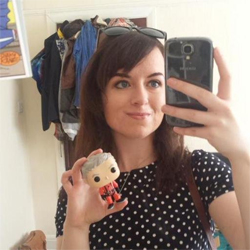Women In Comics Month: Interview With Rachael Stott
Feb 23, 2016
In honor of Women in Comics this March, PREVIEWSworld talks with artist Rachael Stott!
 |
PREVIEWSworld: Tell us a little bit about yourself! What are you currently working on?
Rachael Stott: Hi! I’m a digital line artist, so I do all of the line art on the books I work on from rough layouts to finished inks. I’m currently over halfway through my first run on the Twelfth Doctor comic from Titan.
PREVIEWSworld: How long have you been working with sequential art? What titles, companies, and creators have you worked with over your time in comics?
Rachael Stott: I’ve only been in the industry professionally for a year, though I’ve been drawing comics for fun my whole life- it’s always been my ambition to make a career out of it since I was very young.
My first ever gig was in November 2014, when I was hired by IDW to do their Star Trek/Planet of the Apes crossover (How lucky am I to have that as my first?!)
Chris Ryall had seen my portfolio at a convention and put me in touch with the Star Trek editor Sarah Gaydos, who’s amazing to work with. She was very patient with me being such a newbie. Then after Trek/Apes I did a little work on the ongoing Trek book- (trying to draw that beautiful shiny Enterprise bridge is pretty tricky)- then I was approached by Titan to work on Doctor Who.
PREVIEWSworld: Did you have a mentor or hero in the industry that inspired you to pursue a career in comics?
Rachael Stott: The person in the industry I’ve had the longest association with is John McCrea, as aaaages ago he helped run a comics workshop in Birmingham in the U.K, for kids, which I attended. I remember that it was the first time I’d seen actual evidence that comics were a realistic and viable career goal. After the course ended he was very supportive and would always give me help and advice about my artwork if I dropped him an email. In terms of heroes, growing up I was totally addicted to John Romita Jr, Mike Wieringo, Frank Miller, folks like that.
PREVIEWSworld: In your opinion, how has the comic book industry evolved in terms of gender?
Rachael Stott: I think that the comic industry is ahead of all other entertainment media in reflecting the diversity we see in society. That doesn’t mean that I don’t think there is still a lot of progress to be made, but comics are produced on such a tight, breakneck schedule that they can respond to demands from their audiences faster than say, movies, where budgets and advertisers and those ancient relics leftover from a bygone age (The higher ups, money men and executives are what I’m talking about here) can all be roadblocks to change.
That’s just me thinking on the big three. If you look at indy publishing, there’s freedom now for creators to tell whatever story they want, and distribute it through the internet so it can find a wider audience then ever before. And it doesn’t take a ton of money to produce a product that equals some of the biggest sellers.
I think that in terms of diversity of creators, we’re still playing catch up. It’s true that there are fewer women in the industry, which I assume is a side effect of the 90’s style of comics which were quite alienating unless you were a 14 year old pubescent boy who wanted to see breasts and bums shaped like someone was smuggling watermelons. But you can see how much the quality of what’s being produced today is drawing people in and so in the next few years things will keep getting better and better.
PREVIEWSworld: What stereotypes do you see surrounding women in comics? How could people of all genders go about breaking those stereotypes?
Rachael Stott: To be honest you don’t see many sterytoypes being used anymore- mostly because I think we’re way more conscious as a society now about those issues. It’s only ever been a question of educating people, and we’re getting better at it. Only very rarely is, say, sexism or mysogynism being used maliciously. Normally the person writing or drawing that thing just has a narrow circle of experience of the world., and we have to be mindful of that and understanding. Which is why having a more diverse pool of creators is so important, since you bring that wealth of experience to the work. You end up with better, richer, truer comics, simple as that
PREVIEWSworld: How do you want to see women represented in comic books 10 years from now?
I think we’re off to a good start now. Just continue on, with how things are now as just the starting line. I just want to see a really broad range of representation that more accurately depicts the world we live in.
PREVIEWSworld: If you could give advice to any aspiring editors, executives, writers, or artists, what would you tell them?
Rachael Stott: I don’t feel like I have much authority to give anyone advice! Haha. Artists and writers though –hit your deadlines. There’s nothing quite as hire-able as someone who reliably does that.
PREVIEWSworld: And lastly, are there any up-and-coming women creators who you would recommend readers check out?
Rachael Stott: It’d be hard to think of someone in the industry greener than me, so if I try and recommend someone’s it’s going to be a little weird! There are some fabulous female creators working on the other Doctor Who books- Elena Casagrande on Tenth, Emma Vieceli on Eighth, Adriana Melo on Ninth. Titan are really good for having a fairly even mix of genders creating their comics.
See more Women In Comics Month interviews in our special section on PREVIEWSworld!




